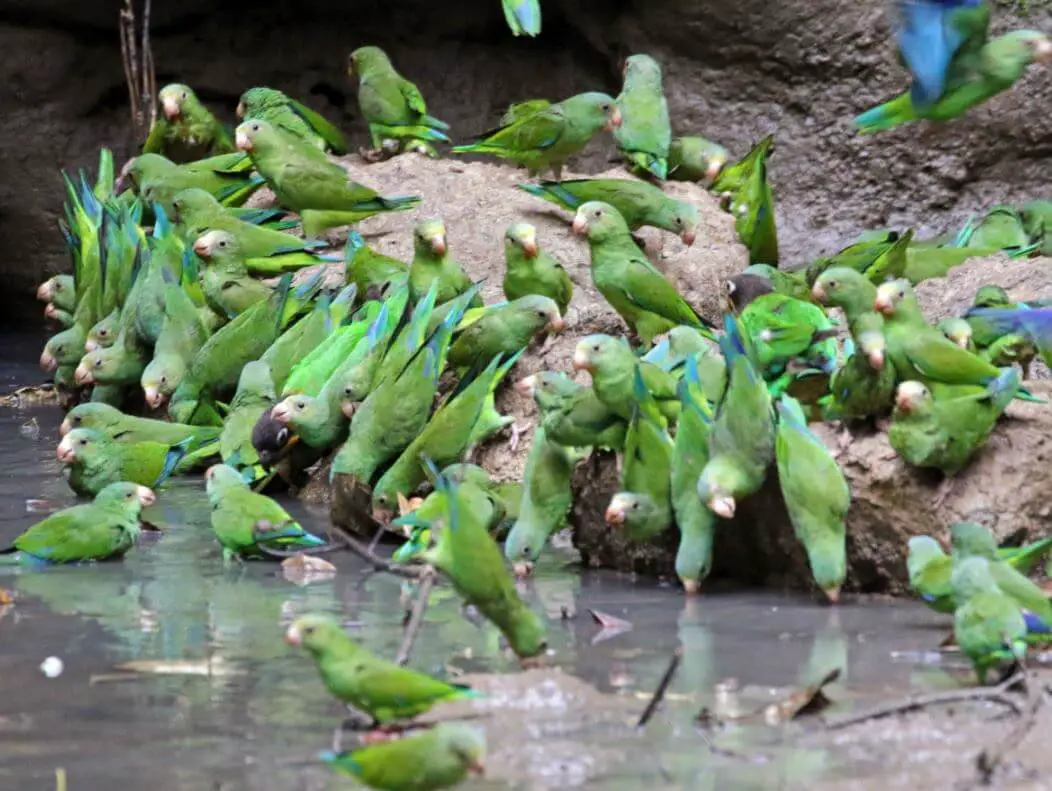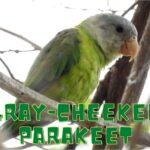
Immature duller. Race Gustavo has little blue on the head, yellow on the carpal edge; Sinensis paler, combining a bluish tinge on the head with yellow on the carpal edge.
Common east of the Andes, from Venezuela to Bolivia, the Cobalt-winged Parakeet is found in humid forests and other semi-wooded areas of the lower tropical zone, mostly to 500m, but occasionally much higher.
It is green overall (paler on the underparts), with blue outer webs of the flight feathers. It has a pale, olive-horn bill and broad white orbital skin around dark eyes, with an apricot throat, fading into the yellow-green breast.
The underwing is green with blue lesser coverts. This species can be distinguished from Forpus parrotlets, which also have blue remiges, by its lack of a blue rump. Cobalt-winged Parakeets are often found in flocks of 10 or more, feeding in the canopy or at forest edges.
Systematics History
Editor’s Note: This article requires further editing work to merge existing content into the appropriate Subspecies sections. Please bear with us while this update takes place.
DNA study indicates that present species and B. chrysoptera are sister species, the two, in turn, being sister to the pair B. pyrrhoptera and B. jugularis.

Subspecies
Brotogeris cyanoptera cyanoptera Scientific name definitions
Distribution
Brotogeris cyanoptera gustavi Scientific name definitions
Distribution
Brotogeris cyanoptera beniensis Scientific name definitions
Distribution
Distribution
Editor’s Note: Additional distribution information for this taxon can be found in the ‘Subspecies’ article above. In the future, we will develop a range-wide distribution article.
Habitat
Lowland rainforest (commoner on higher areas), humid second growth, forest edges, seasonally inundated várzea forest, riverbanks, partly cleared areas, savanna, and llanos; reaches over 1000 m in W of range, but only occasional at 1350 m.

Movement
Apparently sedentary, with some possibly seasonal upslope wandering.
Diet and Foraging
Little information. Recorded visiting flowering and fruiting trees, and eating Cecropia catkins.
Sounds and Vocal Behavior
Common calls include a high-pitched “klee”, shrill “chree” or bisyllabic “chree-chree”, given both in flight and perched. Also a fast chattering series “chichichichichi”. Noisy in flight, individuals of a group often call simultaneously. Large groups can make a loud cacophonous noise.
Cobalt Winged Parakeet
SOURCE: sdclogger
Breeding
Little information. Evidence of breeding Jun–Jul in W of range, including pairs at holes in trees. In captivity: five eggs; hatching occurred in 24 days.
Petipua singing – Cobalt-winged Parakeet (Brotogeris cyanoptera)
SOURCE: Adrianne Bez
Conservation Status
Not globally threatened. CITES II. Common throughout the range, but with no recent evidence of trade, hence rare in captivity. Present in Manu National Park, Peru, where density reaches 16 pairs/km².
Cobalt-winged Parakeets and Orange-cheeked Parrots, Napo clay lick, Ecuador
SOURCE: Andean Birding




















